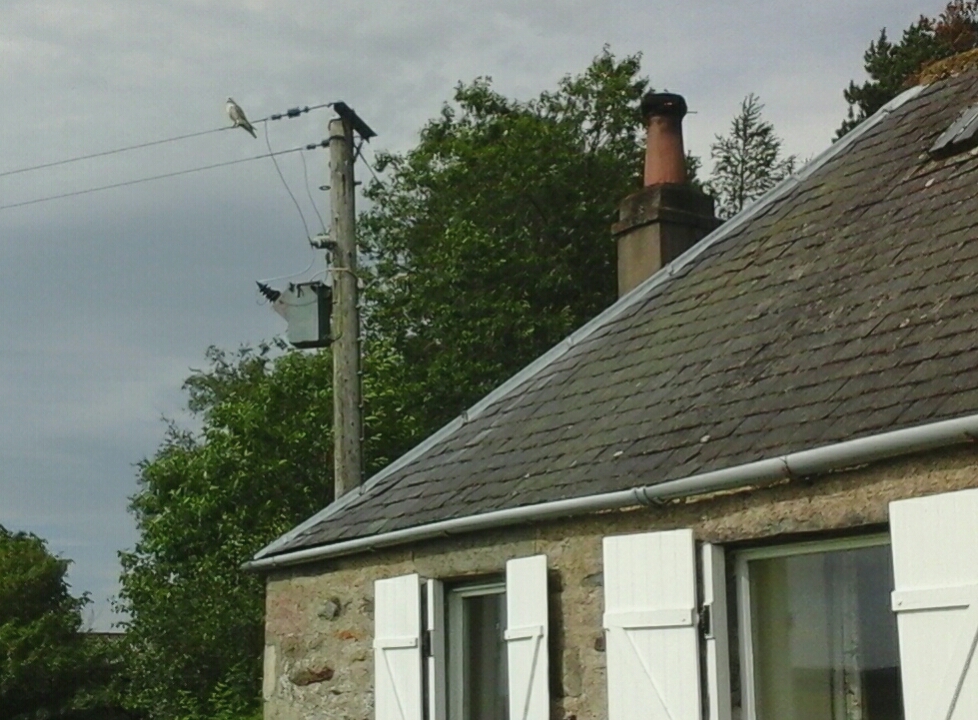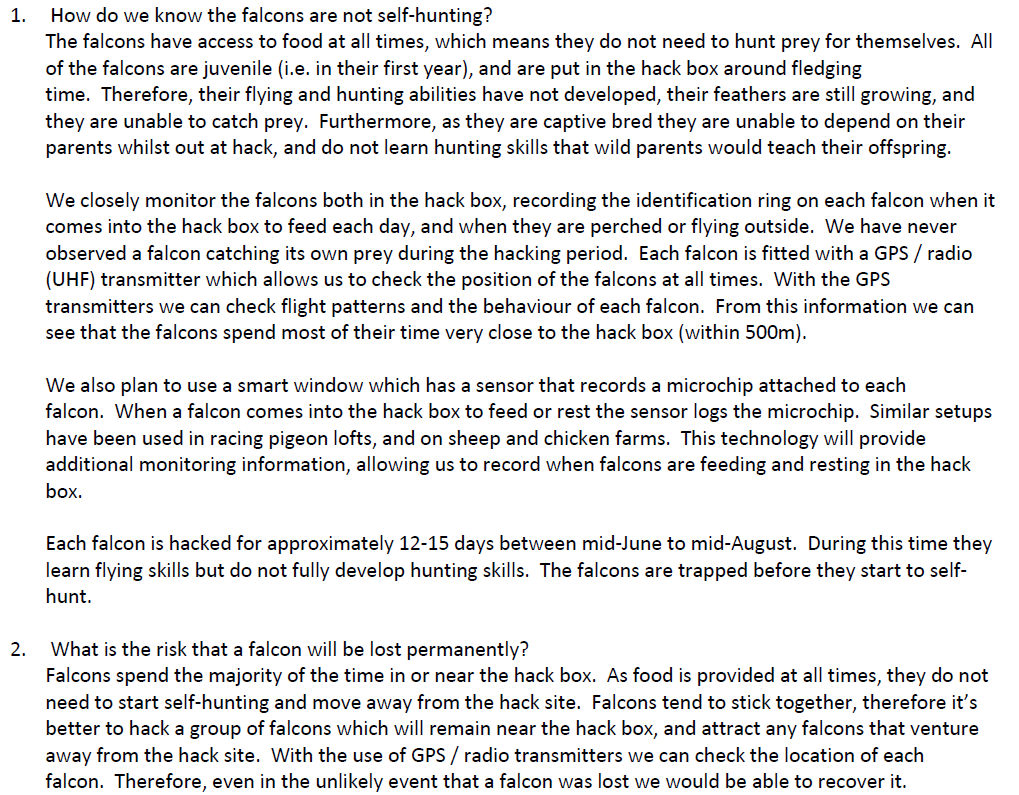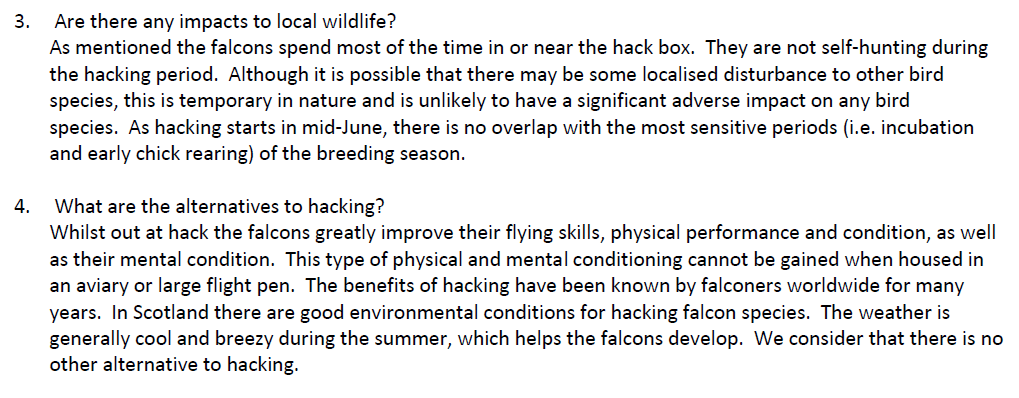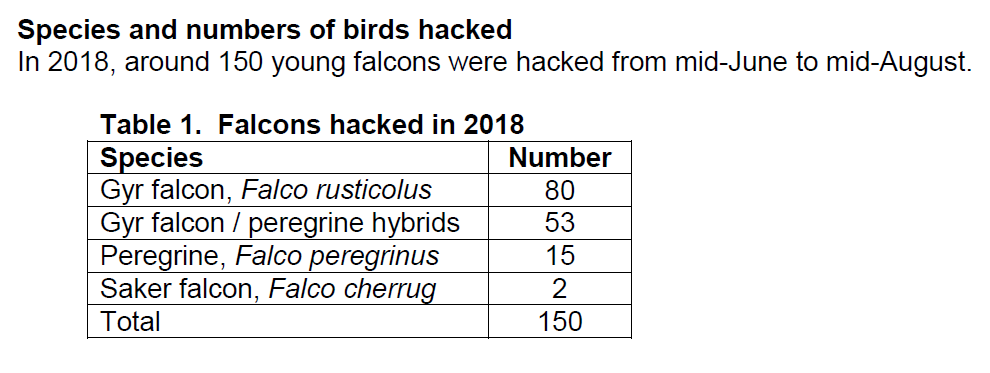
Not many people can get a Gyr Falcon on their garden list…
This is the first of several blog posts this week on what has been learned from an information request to SNH about their licensing procedure for wild hacking of falcons in Moray this summer. To catch up on the story enter wild hacking into the search facility on this blog (top right) and all posts on this subject will be listed.
First, I would preface this blog, and those that follow this week, by saying that I think that SNH have handled the licensing quite well, but it is a novel issue for them to deal with, and I think they are finding their way with this subject. Personally, I believe that shining a light on the process can only help SNH to hone the process over time and ahead of considering any further licences for 2020.
The licensee is UK Enterprise Mission Ltd.
Young falcons have been brought to Moray from a UK Enterprise Mission Ltd breeding facility in the Scottish Borders.
122 Gyr Falcon were wild hacked at the Moray site in 2019 – all were returned to captivity or died in the field (ie there were not escapes that were not eventually recovered).
The following information was provided to SNH ahead of the licence being issued. This, therefore, represents some of SNH’s ‘due diligence’ and the licensee’s account of the wild hacking process.


The licensee gives information about the numbers of birds wild hacked in 2018 as follows:

Since we know from SNH that they did not license any release of falcons for wild hacking in 2018, and that release of hybrid falcons is illegal, it might well be that most of the falcons (135 out of 150) wild hacked in 2018 at this site were released illegally. I’m guessing that the two blogs published here in autumn 2018 might have helped tighten up the licensing of this activity.
This year the licensee wanted to release 150 falcons (a mixture of 80 female Gyr Falcons and 70 Gyr x Peregrine hybrids) with up to 60 birds at a time (Licence application of 8 March 2019) but SNH constrained the licence to 150 Gyr Falcons and ‘only’ 40 birds at a time (email from SNH of 6 May 2019). in the end 122 Gyr Falcons were said to have been released in June-August (and recovered). So it seems that the licensee managed to rustle up an extra 42 Gyr Falcons some time after early May this year for release soon afterwards. I’d struggle to be sure about whether a large falcon was a pure Gyr or a hybrid bird. Which, for example, is that bird on a wire in the image at the top of this post? SNH say they made no compliance visits in 2019.
More on this subject through the week.
[registration_form]
Thanks Mark. I never knew hacking gyrfalcons was an integral part of a 6 star quality private concierge service, https://www.ukme.co.uk/
As the table shows, 53 gyr/peregrine hybrid falcons were flown in 2018.
We know that in 2019, the license was only granted for the wild hacking of pure gyrs. As you point out, no compliance checks were carried out through the hacking season. I am curious to know whether the hacking programme for hybrids was abandoned this year. Without any checks from SNH or anyone else, we may never know.
Another point related to this post is that, being further north and higher in altitude, the breeding season for local birds is slightly later. The release of these falcons and their constant presence corresponds directly with the time when nests either have eggs or chicks and we have seen evidence of nest abandonment occurring within 24 hours of the first batch being released.
The timing could hardly be worse for ground nesting species.
A very interesting topic and it would seem that many of us are learning as we go along. It does strike me that a table which refers to “around 150” , where 150 happens to be a nice round number and not the sort of figure which would be met by the vagaries of a breeding programme, might conceal the reality. When you consider the value of these birds on the market one would expect a more detailed record of exact numbers to be quoted.
One question to be asked is are Gyr/Peregrines sterile? if so their hacking is not a problem particularly as we are led to believe that there are essentially no escapes.
I’ve seen many hybrids at Game Fairs and other country shows and they are difficult to tell from one parent or t’other. The only two that really stick in my mind was a Gyr/ Prairie falcon that looked far too small for a Gyr but was otherwise a white Gyr and a tiny bird I was told was a Gyr/ Merlin.
Paul V Irvine – Does being sterile affect a falcons natural instinct to chase and hunt? Why is our wildlife of little or no concern to so many? Its all about falcons and the business. The escapees are of little relevance here. What about the wildlife in a Scottish glen when 40+ falcons are released for weeks over the summer months to fly as they please. It ain’t a fair fight!
Hybrids: As you say, Mark, it is hard to tell a hybrid from a purebred gyr falcon just from visuals alone. According to a 2005 research paper (Eastham/Nicholls, Morphometric Analysis of Large Falco Species and Their Hybrids With Implications for Conservation, 2005), it is not possible to determine whether a falcon is purebred or a hybrid using morphometric analysis. According to this study, the only way to determine conclusively whether a falcon is a purebred or a hybrid is by DNA analysis.
A declaration from a breeder (even in good faith) is questionable, unless it is backed up by DNA analysis.
If you have ever read any of the old falconry books hacking was done so the young birds would learn to hunt and also wouldn’t imprint on their owners, they were left out at hack and when they started to feed themselves they would become less reliant on the food left out for them, it was at this point they were recaptured.
It seems that SNH at some point late last year or early this year was minded not to issue a licence for this practice. They obviously had reservations – what changed their mind?
Very interesting subject Mark, it’s made for quite an evenings read!
I’ve read a few times that there’s evidence of falcons causing damage to wildlife, it would be fascinating to see more of this if it’s possible?
I’ve known falconers that have released sibling clutches for the purpose that they rarely venture away from their artificial nest, I was told that such fledglings aren’t ready to hunt but when that instinct does kick in, the behaviour can be recognised by flight patterns and with experience – a simple watch of the falcon. The idea was to then catch them before that because to self hunt would mean to venture away from the nest.
Technology was limited then and it’s fascinating to read about the use of GPS and how it changes the traditional proven methods!
The statement in point 2 of the released document makes me wonder because I found some documents online which refer to statistics for Britain. It dates from 1997 so the numbers will be much larger now since falcon breeding is becoming such a lucrative enterprise. Between January 1991 and March 1992, 184 falcons were declared lost. 5% of those were hybrids. 184 lost in just over a year back then, how many will there be now? They probably didn’t use GPS transmitters back then, but how many breeders are using those today? We don’t know.
That same document also mentions that in 1997 there was an estimated number of 13,000 raptor keepers in the UK, keeping up to 18,000 birds. More than 20 years onwards, what are the numbers now? And with a largely unregulated, booming sector, I see danger on the horizon.
Paul S – interesting, thank you. Do you have a link to those online documents please?
I found this online https://www.falcons.co.uk/conservation.asp?id=22 which was very helpful but I don’t think that was wht you were looking at, was it?
Here’s the link:
https://www.researchgate.net/publication/286928990
‘Lost falconers birds and hybrid falcons – do they have an impact on European Peregrine Falcon populations’
Note par 3 under ‘Introduction’:’ … the demand for falcon hybrids … in the Middle East … ‘. The whole paragraph deals with the subject some of us have been discussing.
I also discovered that falconry seems to be banned in most Scandinavian countries. Interesting.
Paul S – many thanks.
I find it odd that many conservationists and raptor enthusiasts on this side of the Atlantic aren’t all that keen non falconry, completely the opposite to that in the US. If it were not for falconers in the US several of their falcon species would be near extinct. In the US raptor research and conservation is largely led by falconers. I’d certainly not ban falconry any more than I would ban shooting or fishing.
However having said that I would be interested to see all evidence of wild hacking damage to native wildlife and not anecdotal but properly studied. I would ban the hacking or flying of any fertile hybrids involving native species.
Then again this is about an associated business not falconry itself and I will repeat what I wrote earlier.
These captive breeding enterprises with or without wild hacking are replacing birds that would otherwise be stolen/taken from the wild. This was and maybe still is a serious problem for Saker, Altai Falcon, Gyr Falcon( in the Russian Federation) and some populations of Peregrine and Lanner in central and northern Asia. Captive breeding may not be without problems but is infinitely preferable to taking from the wild. Banning here would not make an iota of difference in the Middle East so is not and never has been the answer.
Paul V Irvine you would think that a full and extensive survey would have been done before issuing any licence. Given this is the first one to be issued ever in Scotland that would have been common sense. Why the rush?
A community member recently did a FOI request to APHA, asking how many registered captive-bred birds in the UK in 2019. Waiting for a reply.
But most of these birds are destined for the Middle East so do not stay in the UK. There are UK falconers with Gyr falcons flown here but I would think not that many.
Jackie, agreed and please try to spell my name correctly when you use it!
I say, be like Sweden and ban it! Simple.
Wild hacking is desirable to a group of individuals (let’s not forget, the humans behind this travesty), so their birds can build up stamina and confidence etc., to increase their ‘sporting’ prowess and associated value.
Why should OUR environment and wildlife pay for this?
And yes, this activity is banned in Scandinavian countries (yet another example of their forward thinking) and others around the world such as Australia, where it is ONLY legal to ‘free fly’ a raptor for rehabilitation purposes.
Our wildlife probably pays little or anything at all, note each bird is free for about a fortnight from fledging much less time than it takes to learn to hunt.
I would see banning of all falconry as a seriously retrograde step, although I’d not object to a banning of hacking of falconry business birds if this was shown to be a serious threat to native wildlife.
Many probably most UK falconers fly birds that have never been wild hacked these business enterprises have little or anything to do with them.
I’d far rather see falcons flown at grouse, pheasants ( that’s usually Goshawk) or Partridges than any driven shooting.